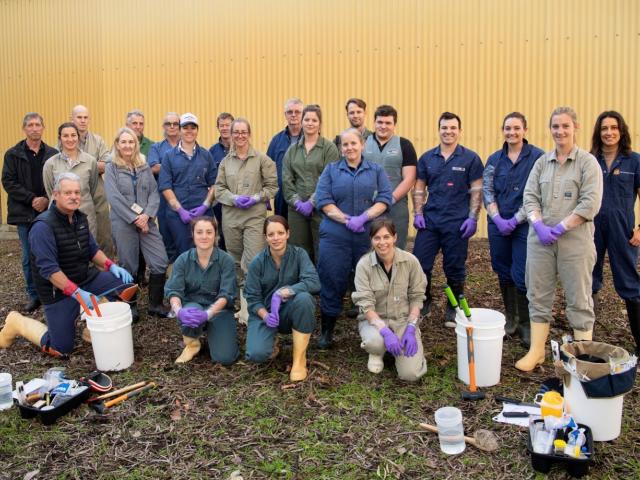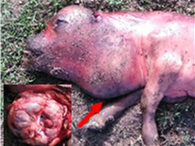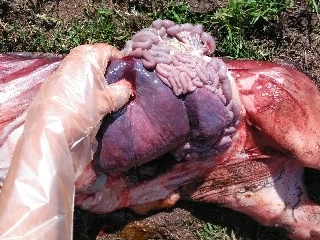| The WA Livestock Disease Outlook - for vets newsletter provides information about recent livestock disease cases in Western Australia and diseases likely to occur in the next month. Calling a vet to investigate diseases when they occur provides surveillance evidence to our markets that we are free of reportable and trade-sensitive diseases. |
Recent livestock disease cases in WA
Case data from July - August 2018
Abortions and deformities in red Angus cross calves
- Four abortions occurred over one month in a herd of 80 five-year-old cows in the Wheatbelt.
- Apart from one cow with retained foetal membranes and diarrhoea, the cows did not appear sick. Two of the aborted calves had enlarged necks.
- The herd was grazing sorghum and being fed cabbage.
- On necropsy of one calf, the head appeared misshapen and the heart, liver and kidneys were enlarged. A melon-sized, liver-coloured, segmented mass had caused distension of the neck.
- Samples submitted to the lab by the private vet showed this mass to be severe thyroid hyperplasia (goitre). The liver was severely congested.
- Glucosinolate toxicoses was the likely cause given the clinical history and lab findings. Glucosinolates are well recognised anti-thyroid compounds and can be found in brassica species such as cabbages, turnips and Brussels sprouts. Prolonged or overfeeding of these vegetables can cause goitre and can be accompanied by abortions, stillbirths and weak calves.
Recommendations:
- Remove brassicas from the herd’s diet.
- Consider possibility of iodine deficiency and supplement if deficient. (Iodine deficiency is another potential cause of goitre.)
- Feeding sorghum also has the potential to cause toxicity in stock if the quality and feeding regime are not well managed. Hungry stock should not be put onto a sorghum-only diet and should be monitored for 48 hours after being introduced onto sorghhum to ensure toxicity does not develop.
- The cows were tested for exotic diseases, such as Brucella abortus, with negative results. B. abortus is an emergency animal disease that causes significant numbers of abortions and infertility and is zoonotic. Vets (especially if pregnant or immunocompromised) should use appropriate personal protective equipment when handling aborted tissues to protect themselves from zoonoses.
- Read more on bovine brucellosis.
Severe neurological signs in heifers in the South-West
- Two heifers, introduced to a herd of 20 late last year, died within a three-month period, both with severe neurological signs of staggering, muscle fasciculations and seizures.
- One heifer was found in lateral recumbency with muscle fasciculations affecting the head and body, a normal body temperature and no menace response.
- Post-mortem of this heifer found mild rumenitis and abomasitis with nodular lesions of the abomasal wall and no other signs of disease. Histopathology of the brain showed acute, cerebrocortical necrosis (polioencephalomalacia) and blood testing showed a severe thiamine deficiency. Tests for lead and annual ryegrass toxicity were negative. Occasional nematodes were seen in the abomasum.
- The herd was being fed hay and kikuyu/rye pasture, but had been moved off hay at the break in season. A decrease in roughage or a sudden change in feed composition is a common cause of thiamine deficiency, which results in reduced energy availability to the brain and subsequent brain degeneration resulting in neurological signs. Cases are often sporadic, but can occur in up to 10% of the herd.
Recommendations:
- Cohort sampling for thiamine deficiency or supplementation of this herd was recommended to reduce further losses. Early treatment of clinical cases can result in improvement although neurological signs may persist if disease is advanced.
- Neurological signs in adult cattle could be a sign of a transmissible spongiform encephalopathy (TSE), a disease exotic to Australia. Subsidised testing for neurological disease in cattle helps us to prove that Australia is free of this disease. For more information, visit the NTSESP webpage.
In spring, watch for these livestock diseases:
Disease, typical history and signs | Key samples |
|---|---|
Coccidiosis in young stock
Recommendations:
| Faecal sample:
|
Cobalt/vitamin B12 deficiency
Recommendations:
| Antemortem:
Post-mortem:
|
Note: Include base samples and any clinical or gross lesions in submissions. For sample submission advice, contact your DPIRD field vet or the duty pathologist on +61 (0)8 9368 3351.
Tips for disease investigations - part 2

At the livestock disease investigation workshops held in June in South Perth, presenter Dr Tristan Jubb provided attending vets with valuable tips and tools for use during investigations, including the following:
Three common mistakes that result in misdiagnosis:
- Bias and denial: Personal bias – you have seen something similar before which biases the information you collect and the tests you do. Producer bias – a post-mortem of the animal a producer is willing to sacrifice rather than the animal showing the most consistent signs with the event.
- Limiting resources: Time and money – forcing off-site investigation and restricting epi information collection, reducing number of animal investigations (e.g. 1 vs 3 post-mortems) and samples collected.
- Forgetting or ignorance: Not knowing what questions to ask or samples to collect.
DPIRD is here to help with these issues – we can help broaden your differential list, provide a sample plan and support follow-up investigation. To find contact details for the duty pathologist and local DPIRD field vet, go to agric.wa.gov.au/livestock-biosecurity/livestock-biosecurity-program-contacts. Put this link in your favourites today!


